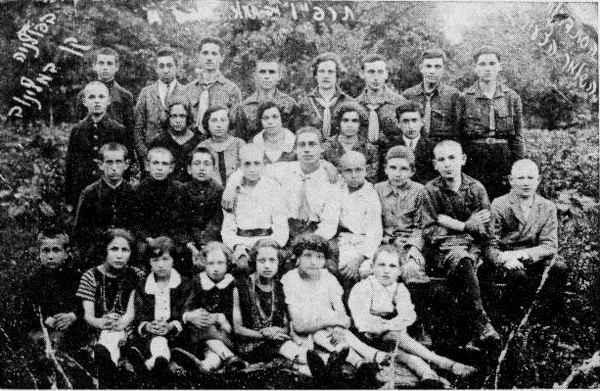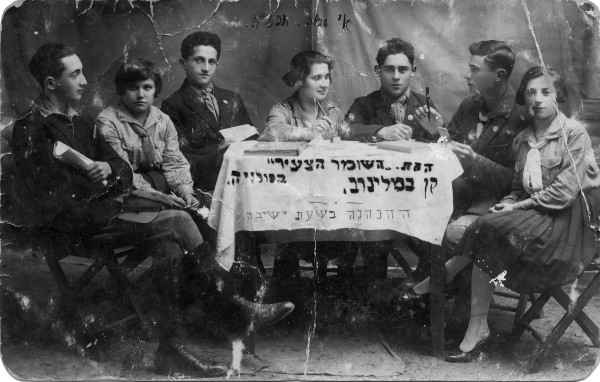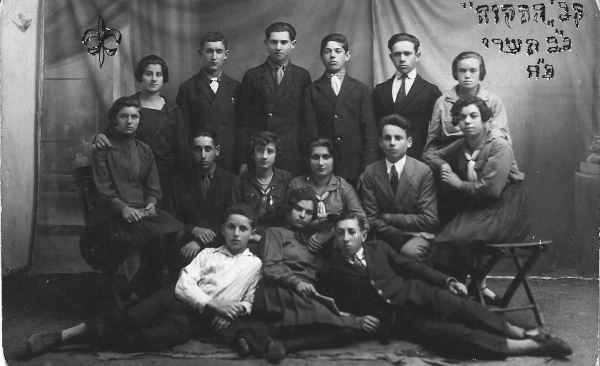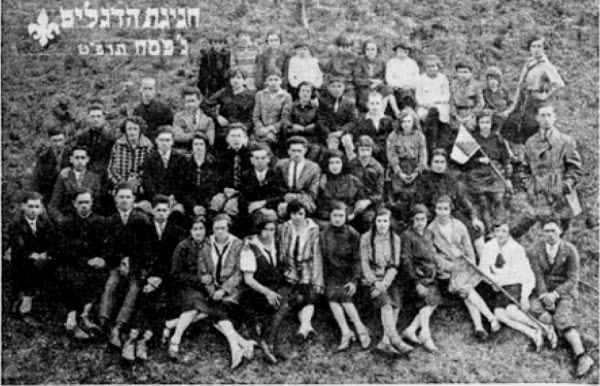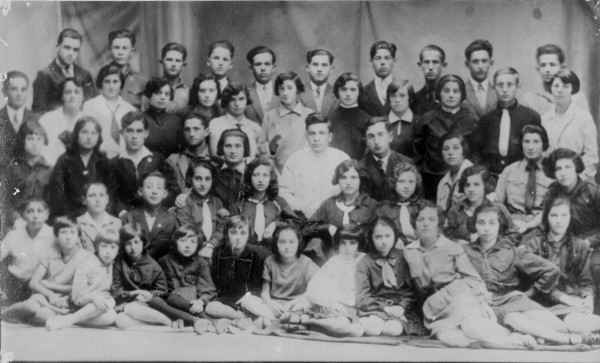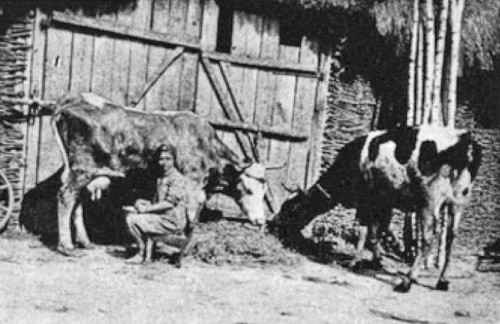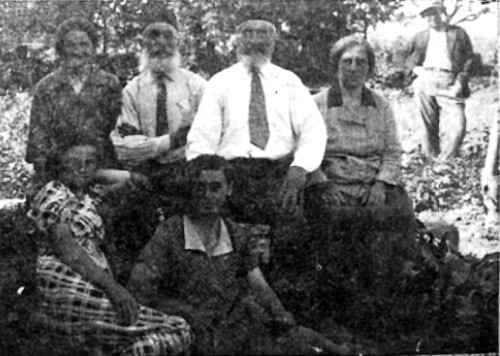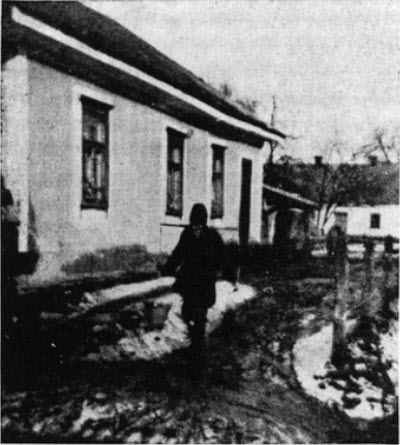[Page 65]
There Was Once a Shtetl Mlynov
by David Fishman, Baltimore
Translated from the Yiddish by Hannah B. Fischthal
Edited by Howard I. Schwartz, PhD
©
Maybe there is still a trace that can be found of our shtetl. If there is, it stands ashamed, weakened, and defiled from all the evil perpetrated there. No Jew is there anymore who can rekindle the Ner Tomid.[1] The Shabbat “lekho dodi”[2] and the weekday “vu rakhem”[3] are no longer heard there. The moon does not have any Jews to bless it every month when it first appears. The river, where even our fathers and grandfathers observed Tashlikh[4] – is also not there.
The pine tree forest, once the scene of the youth of Mlynov and Mervits, alive with songs and discussions and also love, is no longer there. And don't forget the weeping willow trees which provided the branches used during the Sukkot prayer service. Also remember the Mlynov shopkeeper with his fire pot, who used to sit, worried and waiting, for a good Christian customer. Remember the Mlynov market with its passengers going to Dubno (across from Brukhe-Batya's store). I am reminded now of the busy market fairs.
Nu, not only our religious Jews are gone, but also the non-believers, who used to, excuse me for saying it, desecrate the Sabbath. In general, our small-town boys with their dream-filled eyes, who used to look up to the large, wide world, are also gone.
The Christians in the villages cannot throw any more stones into Jewish sukkahs.
It is difficult to take in and to imagine that our Mlynov is really without Jews, really dead, deceased. I would like to know if even our sacred cemetery with the graves is still there.
Editor's footnotes:
- A flame burning perpetually in the synagogue before the holy ark – HBF. Return
- [Come my Beloved], a song in the Jewish liturgical service that welcomes the Sabbath – HBF. Return
- [And He is compassionate] First two words of a request recited during everyday prayers – HBF. Return
- An atonement ritual in which Jews write down their sins and throw the scraps of paper into the river on the first afternoon of Rosh Hashana – HBF. Return
[Page 66]
Culture, Education, and Social Life
in the Small Town
Aaron (Berger) Harari[1], Merhavia
Edited and translated by Howard I. Schwartz, PhD with Hanina Epstein
©
After the First World War, when most of the residents returned from their locations of exile as refugees and the small town had recovered from its destruction – the house of Shulman[2] served as a cultural (tarbut) center in the town. This was a meeting house for all those seeking culture (tarbut). There was the library where they rehearsed plays and in a large-covered patio next to the house, performances were held.
|
|
A group of educated [persons], teachers and those engaged in culture
The teacher Reichman (top right), Shohet and his wife (front right), Miriam Maizlish (standing 2nd from right), Malcah Lamdan (standing 3rd from right), Dvorah Berger (standing left), Samuel Mandelkern (seated left), Clara the dentist (seated center) |
Since all of them were absorbed and influenced by Russian culture, the language spoken was peppered with Russian, and most of the books in the library were in Russian, and a few in Yiddish; there was not a trace of Hebrew books. The club, that centered on the Shulman house, was far from Zionism; and those that shied away from Russian culture, in the club mentioned above, were forced to look for another hangout.
Very slowly a Zionist club crystalized which espoused Hebrew culture and at its center was Samuel Mandelkern.[3] A modern Hebrew school, “Tarbut” (Culture), was established. Many children, who previously studied in heder, transferred to study in the school.
[Page 67]
They were led by an instructional system that was adopted in the schools of the cities and towns. They brought two teachers from outside. Jacob Eisenberg from Rovno (today – [surname] Eshed, in Ein Harod Meuchad[4]) and the teacher Penina from Varkovitchi. In addition, the local teacher was Malcah Lamdan, sister of the poet, Yitzhak Lamdan, z”l, and wife of S. Mandelkern.
Around this school, educational and cultural work was concentrated and flourished. In the evenings, there were lessons for adults, a foundation was put in place for a Hebrew library, and a choir was organized and conducted by Pesach Zutelman.[5] We organized parties in which students dressed up in costumes [drawn from] lives in the Land [of Israel] and choirs with songs from the Land [of Israel]. This was a shining period in the lives of the shtetl youth. The animating spirit in all these activities was again Samuel Mandelkern, without him nothing would have gotten started. He was a person of energy and his initiative had no limit.
I remember the day that the Balfour Declaration was celebrated. There was a large parade in the streets of the shtetl in which all strata of the people participated. The shop owners closed their shops, the artisans left their workshops, the women left their housework – and they all came out to the streets. At the head of the parade was a company of youth riding on horses with flags of blue-white in their hands.[6] Following them, marching in order, the choir, singing Hebrew songs, students from the school, and after them the bulk of the public. The gentiles came out to the street and with surprise watched the Jews in their Palestinian celebration. The chief of police, who was friendly with the local movers and shakers, supervised the order.
We celebrated nearly every Zionist and national event which took place with a very impressive appearance and a large participation. I also remember the banquet, that was put on for the dedication of the Hebrew University on Mount Scopus (Har HaTzofim).[7] This was organized in good taste, and participation included local government officials and honored individuals who were invited as well as educated gentiles. In addition to the gastronomic program, there was an art program that enchanted all those present.
To be sure, there were ups and downs in the cultural and educational activities. The Hebrew school sometimes closed and opened again, whether due to a lack of teachers or the small number of students. But the study of Hebrew continued all the time, even with a reduced class size.
In order to create the foundation for first grade (kitah aleph) [Samuel Mandelkern] had the idea to create a kindergarten that would serve as a natural transition to the school for the children and parents alike. Mlynov parents had never sent their children to kindergarten and this was the first attempt in the shtetl. We had to make an intensive effort to convince the parents to send their children to the kindergarten. The parents first convinced to do so were few in number and had a relationship of some sort to Zionism and Hebrew culture. The rest of the parents from the regular folks, one by one, sent their children to the kindergarten; the idea enchanted them and they were convinced. A parental committee was chosen that joined us in attending to all the technical and organizational arrangements for the kindergarten. The female kindergarten teacher and the children together prepared the celebrations [lit. “spirit”] of Hanukah and Purim and this introduced vigor and life to the shtetl, which was entirely lacking sources of amusement and recreation.
[Page 68]
By the way, the female teachers that worked during the years of the kindergarten's existence and the teacher Zilberg–they had been educated by [the youth group], The Young Guard (Hashomer Hatzair).
For many years, a drama club existed in the shtetl, from the effort of and during the time of Samuel Mandelkern, which put on the best of Jewish repertoire. The club operated on a very high artistic level. All the people of the shtetl would come to the shows except the religious extreme and the elderly. The actors were of the same generation as Samuel Mandelkern, and when [Samuel and Malcah] married and Samuel made aliyah to the Land, we continued the tradition: Lipa Halperin, z”l,[8] Yehuda son of Eliezer,[9] and the writer of these lines. The income was dedicated to the goal of education and culture. Periodically, a drama troupe came from outside of town, and we contributed the organizational help required. Thus, there was a continuous series of plays and receptions.
With a group of youth, we attempted to organize an orchestra of wind instruments without borrowing. We bought new instruments and brought a Czech teacher from the Czech settlement of Maslianka[10] but the attempt failed. After a number of months, they were fed up with the effort and the instruments turned to junk.
Sport activities which the youth engaged in were: swimming, boating, volleyball, cycling, and ice skating. There was no group organized for the purposes of municipal sporting competition. Both Jews and gentiles, office workers and teachers, played volleyball. The playing field was on the bank of the beach, near the river. The beach was busy in summer with many of the youth, especially in the afternoons and the Sabbaths.
|
|
| A “Tarbut” school during the festival of Lag B'Omer, 1919 |
Editor's footnotes:
- Aaron Harari was born Aaron Berger (1908-1984), one of five children of Wolf Berger and Golda (Kentor). Aaron played a leadership role in the Zionist youth group, Hashomer Hatzair, in the 1920s and participated in a training kibbutz (hachsharah) in Slonim, Russia before making aliyah in 1934 with the Planty group and settling in Kibbutz Merhavia. He later became a well-known expert on sheep breeding. On the history of the Berger family, see https://kehilalinks.jewishgen.org/Mlyniv/families.html#Bergers Return
- The Shulman house refers to the home of Tsodik Shulman (1863-1947) and his wife, Pearl Malka (Demb) (1865-1933). Tsodik was the nephew of the famous Kalman Schulman, a maskil and Hebrew writer whose work was significant in the development of modern Hebrew literature. Tsodik was recalled in family memories as being responsible for overseeing the Count's forest. The Shulmans had seven children, five of whom accompanied them in 1921 to Baltimore. The Shulman library was also remembered by Mervits-born, Benjamin Fishman, as the place where he was able to meet and court his future wife, Clara Shulman. On the history of the Shulmans, see https://kehilalinks.jewishgen.org/Mlyniv/families.html#Shulman Return
- The Hebrew sometimes is rendered in English as “Mandelkorn.” Return
- The kibbutz Ein Harod split in the 1950s into two kibbutzim distinguished by those who supported Stalin loyalists and the those who followed Ben Gurion and his preference for the US. Return
- Pesach Zutelman or Settleman migrated to Baltimore with the Shulman family and became Paul Shulman in the US. Return
- A precursor to the blue and white flag of Israel was made in 1891 for the Zionist movement. The basic design recalls the Tallit, the Jewish prayer shawl, which is white with black or blue stripes. Return
- The Zionist movement envisioned a Hebrew University in Palestine and the dedication of the original stones took place on July 24, 1918. Return
- Lipa Halperin is a contributor to this volume. See his essay, “The Mill,” 15-16. – HS Return
- Referring to Yehuda Mohel. On the Mohel story, see Dani Tracz, Riva and Yehuda: Life Story of Trancman, Mohel, Tracz and Ben-Eliezer Families, 2015. Trans. from Hebrew by Lynda Schwartz. D.C.P. Haifa, Tel Aviv, Israel, 2017. – HS Return
- The settlement has not been identified. – HS Return
[Page 69]
The Youth Movement, “The Young Guard” (Hashomer Hatzair)
by Aaron (Berger) Harari[1], Chicago
Edited and translated by Howard I. Schwartz, PhD, with Hanina Epstein
©
The initial establishment of “The Young Guard” (Hashomer Hatzair) in the small town was in the summer of 1920 by a young man from Rovne[2] by the name of Lemel Rosenfeld, who visited as a guest with the family of Chaim Berger. As himself a member of The Young Guard, he organized around him a number of friends his own age and he led them in activity; afterwards they continued on their own.
In the “nest”[3] then there were two groups, one of older youth – ages 15–16, and the second younger, ages 12–13. The two groups were comprised of boys only. I belonged to the younger group, which numbered 10 boys. I remember the first meeting, that took place one evening in the classroom of the Hebrew school. David Maizlish, z”l, spoke to us and explained to us the essence of The Young Guard and its true ethical significance for Hebrew youth. His words kindled sparks in our hearts and breathed new life in us. A sacred trembling and an adult seriousness passed over us even though we were still young lads.
|
|
A “Hashomer Hatzair” nest in Mlynov in 1926[4]
Original courtesy of Dani Tracz (Issachar Mohel) |
[Page 70]
This took place during the summer months as we gathered twice a week outside the shtetl on “the Greenik,”[5] a place so called by everyone, which was a small hill next to the Count ['s estate], at the intersection of the dirt road to Dubno. The main activity that we engaged in was orderly exercises. We marched as a group according to military formation and according to the commands: “Listen,” “Attention,” “At Ease,” “Left Face,” “Forward March,” “March in Place” and so forth, all the commands being given in Hebrew, and also the communications were conducted in Hebrew. We also sang songs of our homeland and our greetings were: “Be strong” and “Be strong and courageous.”
The summer passed, and the rainy days of fall began, and the activity outside completely ended. Occasionally, we would go into one of our houses on Shabbat afternoon, and the guides[6] would read a book or newspaper for us. But after a time, this ended too [because] the guides emigrated to Argentina,[7] and there was no organization in the shtetl or initiator who could do something to organize the youth. Samuel Mandelkern led a club to read the legends [aggadot] of Bailik and Rawnitzki.[8] Due to a lack of participants even this group did not last long. In the small town, a complete cultural wilderness prevailed. This situation continued for several years.
|
|
The sign reads: “Hashomer Hatzair nest in Mlynov, Poland.
The leadership during its deliberations.”
Original courtesy of Dani Tracz (Issachar Mohel)[9] |
During the summer of 1925, I wrote a letter to the headquarters of The Young Guard (Hashomer Hatzair) in Warsaw and I requested help to establish a nest for the movement. I received a shipment, that included diverse instructional booklets, but, to be honest, I had no idea how to implement the efforts of organizing the youth and what to do with them afterwards. As a first step, I decided to announce the matter widely. The publicity spot in the town was the synagogue. I made an announcement with the following approximate language:
[Page 71]
“The organization of 'The Young Guard' is organizing and all boys and girls who want to belong to the organization should come sign up with Aaron Berger.”[10] I hung the announcement on the Sabbath eve (Erev Shabbat) in all three of the synagogues. During the week, dozens of youth signed up from all ages. I involved several of my friends in this effort and I split those who registered into two groups.
Every Shabbat we would go in a forest at a distance from the town. We sang songs of the homeland, played sports, read booklets about what was happening in the Land of Israel (Eretz Yisrael) and we felt a sense of unity among the youth. This is how the summer passed but since there was no place to gather [at the end of summer] the activity ceased.
In the spring of 1926, I took a course for leaders in Rovne, where I stayed for a week and met for the first time with dozens of guides from other nests, from the towns of Volyn and its various towns. I heard lectures on educational and organizational challenges from members of the principal leadership. My eyes were opened and I returned home crammed full of knowledge and enthusiastic about the practical value that I had derived from the course.
I invited Yehuda Mohel (son of Eliezer) and suggested a working partnership to organize the nest again. I read to him the notes from the lectures I had heard, and with energy we once again tackled the work with the youth. Since we now had some guidance in our hands, we were able to accelerate momentum with greater confidence. We established a quorum of local guides, rented an apartment for the nest – and the activity began.
|
|
Group HaTikvah 1927
Original courtesy of Hagar Lipkin[11] |
[Page 71]
The members of The Young Guard stood out in the small town with their special dress and scarfs symbolic of the movement. The activity started in the summer outside, under the dome of the heavens. We had designated places to meet: by the May 3rd monument,[12] the Greenik,[13] the hills on the way to Mervits, the “Young Guard Grove” across from the palace of the property owner [the Count], etc. In the winter, we gathered in the clubhouse, which was filled late into the night with youth who were joyful and happy, spoke pure Hebrew, and sang new songs of the Land of Israel (Eretz Yisrael).
We, the guides, visited periodically those nearby [groups] in Dubno, because from an organizational perspective, we belonged to the Dubno chapter of the movement. There we would meet with members and guides of the nest, and we learned from them the methods of doing educational work with the youth. In addition, we were visited by representatives from the principal leadership in Warsaw and representatives of the movement from the land of Israel (Eretz Yisrael). We participated in rotating national conventions in summer camps and in leadership meetings. All of these expanded our horizons and we saw ourselves as part of a flagship “Guard” group in Poland.
|
|
| The text in the photo reads, “Festival of the flags, Passover, 5689 (April 1929).” |
The nest carried the yoke of the Zionist and cultural activity on its shoulders. Apart from The Young Guard (Hashomer Hatzair), there was no other Zionist organizations or youth movements. Subsequently, “The Pioneer” (HeHalutz) was established, and all the graduates of The Young Guard became members automatically. A few members also joined who had not been members of “The Young Guard.”
The nest organized parties and plays which many of the population attended and the income was dedicated to cultural activities. The youth in small towns like ours, which was enclosed in 4 walls [literally in “4x4” cubits], and was isolated from the outside world, found in the walls of the nest the information for what needed to be done in the land [of Israel] and first knowledge of Jewish culture.
[Page 73]
In group discussions, they covered material and subjects that were not taught in school. The guide would prepare by studying books before bringing his thoughts to the group. The youth would come to the library and exchange books, and a lively educational and cultural operation was noticeable among the youth.
As the nest reached its full momentum of activity, harassment began. From one side, the local rabbi, preached in his sermons in the synagogue against “The Young Guard” (Hashomer Hatzair) …. according to him, the educators [of The Young Guard] were leading the youth away from Judaism, mercy upon them. From the other side, the principal of Polish school forbade the students to belong to the nest and this was a very difficult period for the guides who carried the responsibility for the activity. But in spite of all the difficulties and persecutions, our activities continued, some clandestinely.
We sent a delegation, drawn from the best of our guides, to the Rabbi, and we tried to convince him that there was nothing in our activity harmful to the youth because we didn't teach against the religion. Of course, the rabbi didn't agree with us, but the visit and conversation reduced the severity of the attack a bit. Furthermore, we presented ourselves to Mr Veinstock, who was influential with the local government and requested his intervention with the principal of the school on our behalf. Indeed, the persecutions from this side ceased.
|
|
Nest of “Hashomer Hatzair” – 1929.
Going away party for the aliyah of Yehuda Mohel.[14]
Original courtesy of Dani Tracz (Issachar Mohel) |
* * *
The older mature members began steps towards fulfilment [of aliyah]. Some went to preparatory training (hachsharah) and dreamt of aliyah to the Land, and the nest made aliyah in purposeful bands. The first person to make aliyah from the nest was Yehuda Mohel. After him – Moshe Chizik (or Tzizik),[15] z”l, Moshe Teitelman (Tamari),[16] Tzipporah Holtzeker,[17] Rosa Berger.[18] Rachel Kipergluz ([married name] Kleeman), the writers of this essay, and others. With the aliyah of the senior guides to the Land [of Israel] and with the young guides going to preparatory training (hachsharah), a difficult setback befell the nest, and all activity was silent.
Most of the townsmen who are present today in the Land [of Israel] in the city or kibbutzim, were members of The Young Guard (Hashomer Hatzair) who had absorbed the culture of the youth movement. They surely remember the days and nights of their childhood and youth, which they spent in an atmosphere alive and animated, which gave them purpose in life and the [desire to] pursue the pioneering ambition.
From “Masada”
by Yitzhak Lamdan[19]
The chain is still not broken,
The chain still continues,
from father to child,
from bonfire to bonfire,
the chain still continues…
The chain is still not broken,
the chain still continues,
from night of Simhat Torah
to nights of Simhat Masada:
the chain still continues…
Thus danced our fathers;
one hand on a neighbour's shoulder,
the other holding a scroll of the Law–
a people's burden raised with love–
thus danced our fathers…
So let us dance;
one hand gripping the circle,
the second clutching the load of a generation,
a great, heavy book of sorrow–
so let us dance…… |
Translator's footnotes:
- See the previous essay for Aaron Harari's biographical background.--HS Return
- Today, Rivne, Ukraine.--HS Return
- “Nest” (ken) is the Hebrew term for a Zionist group or club. Nest was used in the English to capture this original terminology. Return
- Aaron Harari, the author of this essay, is back row, 3rd from the left. Yehuda Mohel is in the back row, second from the right. Return
- The Hebrew here reads “Agreenik” but appears to be the same hill called “Greenik” in the photo of the young people standing on the hill on p. 158 in this volume. See also the essay in this volume, “My Hill,” 30, by Moshe Teitelman, probably about the same hill, known by the young people as “Mount Sinai” and which held a special place in the life of the town's youth. Return
- The Hebrew term can be translated as either counselor, leader or guide. Guide seems most appropriate since counselor makes it sounds like a summer camp and does not seem to capture the serious goal of the activities. Return
- The author's older brother, Kalman Berger, was among a group of Mlynov boys who made their way to Buenos Aires on the way to the US between 1923–1926. Other Mlynov young men who followed the same route included Frank Settleman, Samuel Goldseker, Julius Deming, and brothers, Morris and Isadore Wallace. On the Mlynov boys in Buenos Aires, see https://kehilalinks.jewishgen.org/Mlyniv/mlinov_in_WWI.html#BuenosAires Return
- Hayim Nahman Bialik (1873–1934) was born in Volhynia and was a pioneer of modern Hebrew poetry. Bialik and Yehoshua Hana Rawnitzki (1859–1954) together published Sefer Ha-Aggadah (“The Book of Legends”), a compilation of legends from the Talmud. Return
- Yehuda Mohel is seated second from the right and Aaron (Berger) Harari is third from the left. The story of Yehuda Mohel is told by his son, Dani Tracz (Issachar Mohel) in “Riva and Yehuda: Life Story of Trancman, Mohel, Tracz and Ben-Eliezer Families”. https://openlibrary.org/books/OL26355878M/Riva_and_Yehuda Return
- Aaron Berger was the birth name of the author. Return
- Rosa Berger, front center, Rachel Shapovnik, middle row right, Chuna Goldseker, middle row, second from the right. Return
- May 3rd is a Polish national and public holiday that celebrates the declaration of the Constitution of 3 May 1791. Return
- See note 4. Return
- Yehuda Mohel is seated in the third row, center, with the white shirt. Aaron (Berger) Harari is in the same row, (third row, 4th person from the left). Others in row three: Moshe Chizik (or Tzizik) (Rosa's future husband) (3rd from left), Yehuda's sisters, Bayta Mohel (5th from left), and Dvorah Mohel (1st from right with dark tie). In row four standing: Rachael (Shapovnik) Givol (4th from left in dark dress), Aaron's sister, Rosa Berger (5th from left in white shirt and tie), Yaakov Mohel (Yehuda's brother) (2nd from right in dark shirt and white tie). Back row: Saul Halpern (3rd from right), and in second row from front: Yitzhak Gelberg (first on left). Return
- Moshe Chizik (also Tzizik) (1909–1959) made aliyah and eventually married Rosa Berger from Mlynov. He died prematurely of a snake bite. Return
- Moshe Tamari was born in 1910 as “Moshe Teitelman,” in the town of Varkovitch but his family moved to Mlynov to make a living and Moshe spent a good part of his youth growing up there. He contributed two essays to this volume, “My Hill” and “In the Presence of Yitzhak Lamdan.” He became Moshe “Tamari” sometime after making aliyah in 1933 and wrote and published a number of books and stories in Israel. Moshe's father, Anshel, was an older brother of Nahum Teitelman from Mervits, who also published an essay in this volume. Moshe lost his parents and his brother in the liquidation of the Mlynov ghetto in October 1942. Return
- Tzipporah Holtzeker (1910 – 1986) was second eldest of twelve children of Yaakov and Rosa Holtzeker and made aliyah in 1933 with the Kibbutz group Wahlinia B" and settled first in Rishon LeTzion and then Givat Keren Kayemet and eventually Kibbutz Negba. Most of her family was killed in the Shoah. A sister, Baila, and brother made aliyah and joined her in Palestine. Another brother, Hanoch, escaped the Mlynov ghetto liquidation, made his way to Palestine, but was killed defending Negba, in the War for Independence in May 1956. Return
- Rosa Berger (1910 – 1994) is the sister of Aaron (Berger) Harari, the author of this essay. She made aliyah in 1933 with the Planty Group and eventually married Moshe Chizik (or Tzizik) who also made aliyah from Mlynov. Return
- From Yitzhak Lamdan's poem, Masada, from the part called Night Bonfire, section 3. Translation from Leon Yudkin, Isaac Lamdan: A Study in Twentieth Century Hebrew Poetry, p. 213. Ithaca: Cornell, 1971. Return
[Page 75]
Jewish Farmers in Mlynov
by Aaron (Berger) Harari[1]
Edited and translated by Howard I. Schwartz, PhD, with Hanina Epstein
©
Not many in Mlynov engaged in real agriculture. I knew only of my uncle Faivel and my father, z”l.[2] The two of them loved agriculture and found meaning in their life by fulfilling the commandment, “bring forth bread from the earth”[hamotzi lehem min haaretz].[3]
My uncle had a large vegetable garden that was spread out over an area of approximately 5 dunams,[4] as well as dairy cows. Our family also had dairy cows and in cooperation with my uncle we worked large fields that we rented them from the owners of the property in Smordva.[5] The fields we received needed first to be prepped for agriculture, by removing roots from the forest trees and burning shrubs, and bramble, and filing up ditches. My father and uncle thus invested much effort even before they were able to work the land. Afterwards, they grew wheat, barley and seeds for making oil. In addition, we had fields of hay for feeding the cows. These fields were harvested twice a year.
|
|
Batia, daughter of Faivel Berger, milking the cows
From the photos of A. Harari |
My father and uncle would rise early in the morning, hurry through the morning prayers (shaharit), and go out to work. Most of the work – plowing, sowing and transporting– they did themselves, and only during the harvest and threshing season would they get help with hired workers. At the busy time, household members would be enlisted to help. During the summer, during free time from studies, I would work with the hay, hauling it, threshing it, and so forth.
[Page 76]
Nevertheless, working the leased land did not last many years. Once the owner of the property realized that the cultivated fields were producing a good crop, and there was apparently no contract in place related to working the land, he reclaimed the land and no longer leased them to us to be worked. Thus we were left embarrassed by all the agricultural equipment that we acquired: threshing machines, plows, an [agricultural] harrow, sickles, scythes, and more. From that point on, the agriculture was reduced in favor of raising dairy cows only, and therefore they had to acquire an independent supply of hay which we bought from the owner's holdings for which we paid in hard cash. We also continued to grow potatoes on the land that we received in exchange for manure. In addition, my uncle continued to grow vegetables on the personal plot next to his house.
We would sell the milk to regular customers, who came daily to the house to get it. From the surplus milk, we would make butter and cheese. I remember how Father would awaken me every morning, before sunrise, in order to take the cows out to pasture. I would take a book to the pasture with me and prepare my lessons and return home before I went to school.
* * *
It is a pity Jews such as these did not at the time make aliyah to the Land [of Israel] and settle in some agricultural settlement (moshav) and invest their life energy here, instead of preparing the land for strangers….
During my visit to Mlynov in 1937,[6] my uncle, Faivel, implored me to try to help him make aliyah to the Land, so he could engage in agriculture here, which was his desire – but the matter was not realized.
|
|
Faivel Berger (center right), Wolf Berger (center left) – and their families[7]
Original courtesy of Zeev Harari |
Translator's footnotes:
- See above page 66, footnote 1, for Aaron (Berger) Harari's biographical background. Return
- Aaron's father was Wolf Berger. Return
- These are the words said during the blessing before eating bread. Return
- A measure of land area used in part of former Turkish empire including Israel, where it is equal to about 900 square feet. Return
- 12 km from Mlynov. Return
- In the next article, Aaron relates his trip to Mlynov was in 1938. His son believes it took place the winter of 1937–1938. Return
- Part of Aaron's family who perished in the Shoah. In the list of martyrs, p. 431, Faivel Berger is also called Sharga. His wife's name is Matil. His daughter, Batia, is seated front right. She was the one milking the cow on the previous page. Wolf's wife, Golda, seated left, and his daughter, Hannah. Return
[Page 77]
Visit to Mlynov in 1938
Aaron (Berger) Harari[1]
Edited and translated by Howard I. Schwartz, PhD with Hanina Epstein
©
Only four years passed since I made aliyah to the Land [of Israel], and what a great chasm was created between me and the people, whom I had left in the town. What a different feeling I had getting off the bus and passing down the main street. When the shop owners saw me, they indeed stared at me with great curiosity. In truth they were the same Jews – but in my eyes they seemed different. And when I met acquaintances, close and dear friends, I no longer had a common language with them. Every one of them was odd to me, as if I was hurled into another world…their gait, their ways of speaking, and their activities, aroused pity in me. I believe it was not from excessive arrogance that I felt this way but rather from an expression of an internal transformation that occurred in my personality during the 4 years of my acclimation in the Land [of Israel], with a full and intensive life in work, in the workers' movement, in the kibbutz, in agriculture and in defense. All of these left their mark on my soul and character such that I was not able to find my place in the suffocating social and cultural atmosphere that I found in the small town.
The few older members of The Young Guard (Hashomer Hatzair) were waiting for their aliyah and the nest no longer existed. The youth sought out questionable entertainment spots, and the older ones spent their time in the billiard hall, that had been opened in the home of Shimon Schechman.[2] Out of curiosity, I visited the clubhouse mentioned above and I was shocked by how the youth were spending their time. No cultural activity was conducted in the town and also no one was initiating any activity.
My visit aroused curiosity in the town. I was, in fact, the second visitor from the Land [of Israel] after Yitzhak Lamdan. In personal meetings and conversations, I was asked a great deal about the Land, and I was talking nonstop. Even the gentiles who recognized me from earlier days came to visit me and were interested in Palestine– the Jewish State – and the educated among them asked pertinent questions.
My father,[3] may his memory be a blessing, insisted I go with him to the synagogue on the Sabbath –although he knew that I was not in the habit of praying. In order to prevent my being called to the Torah, which made me uncomfortable, I refused him. In the end, I agreed with an explicit condition, that before the reading of the Torah portion for the week, I would leave. It was a great honor for my father that I accompany him to the synagogue. Many of the homeowners grabbed my hand with the greeting
“Peace be upon you” (shalom aleichem) and grabbed my coat and smelled it, perhaps there is something special from the smell of the Land of Israel (Eretz Yisrael)…Father prayed from a prayerbook bound in a fancy olive wood cover that I brought from the Land, and many looked at him with envy.
[Page 78]
After that, I indeed regretted what had happened– because what, really, did it matter to me to go up to the Torah, to be honored with the “maftir” and to read the haftarah in the Sephardic congregation with the cantillation notes?[4]… Then my father would have been radiant with joy and happiness. Therefore, I had regret about this, but what was done couldn't be undone.
That same Shabbat, father invited his friends to the house for “Kiddush”[5] and he honored them with wine from the land of Israel, “Carmel Mizrahi”[6] wine, which I brought from the Land and with cake from the Kibbutz, that I received as provision for the journey which had held up in spite of the bumps along the way. As is the custom in small towns when a guest comes, friends and relatives send “treats” (mishloah manot) to him at the house. That same first Sabbath of my visit, we received as gifts: bottles of liquor, cakes, various pastries, and especially one gift, which is worth mentioning: the children of the ritual slaughterer (schochet),[7] Eliezer Mohel, sent a traditional Jewish stew (cholent) which included stuffed entrails and stomach.
The goal of my visit was to help a sister, of one of the Kibbutz Merhavia members, make aliyah. Since I had come on an individual passport, and I had Land-of-Israel[8] citizenship, I would be able to add her to my British passport via a fictious marriage and bring her to the Land without a certificate,[9] which in those days was hard to come by. Out of fear of bad luck and from what people would say, I told a different story entirely. Most in the small town knew that I was engaged in raising sheep in the Land [of Israel], and [understood] that my visit was related to business involving sheep and wool. My parents, in their naivete, also believed this story. Until one day clear day, I revealed to them the secret. I told them that in the coming days a young woman would visit in our home and she was the sister of a member of my kibbutz, and it had fallen on me to help her make aliyah to the Land of Israel, but that there was nothing between us. In order to carry out the plan, I needed to arrange a fictitious wedding. My parents had a hard time understanding the meaning of a fictitious wedding. In their view, there was only one special meaning of a marriage: bride and groom, in-laws, with rabbi under the canopy (hupah) and betrothal (kiddushin).[10] I struggled a great deal until I succeeded in explaining this to them. They only relaxed when I said that all this would not take place in our shtetl but by the British ambassador in Warsaw.
My visit home continued to bring my parents satisfaction. In the evening, special friends visited as well as neighbors. Parents, who had children in the Land [of Israel], came to ask about their well-being, who thought, in their innocence, that the Land of Israel (Eretz Yisrael) is a “colony” and everyone lived together, and I met, at least daily, with all of them. From the stories I told about the Land of Israel, what made an impression on them was that rain didn't fall from Passover to Hanukkah, [that] herbage could be harvested almost all year long for the cows, that oranges were cheaper than other necessities, and so on and so forth.
I had the feeling that this was my first and last visit to the town and I said to myself, it is worthwhile immortalizing the scenery and the different typical characters. I had with me a cheap kind of camera, that I borrowed from a member of my kibbutz, from which it was difficult to get photos deserving to be so-called, due to the winter weather and my own inexperience with photography.
[Page 79]
To my bad luck, it was necessary to convince people that I was interested in them, in all the ways I could think of so they would let me photograph them – but I was not always successful.
I found many changes in the town. New paved roads and much work on fortifications going on all around, as defense against the Soviet Union. Therefore, the many foreigners involved in these fortifications, wandered around in the streets.
|
|
Herschel “Duetino,”[11] drawer of water, near the house of Yaakov Holzeker[12]
Photo of A. Harari, 1938 |
Editor and Translator's footnotes:
- See page 66, footnote 1, for Aaron Harari's biographical background. Return
- This probably refers to Shimon Schechman, son of Moshe Schechman and Faiga Beshe Wolk. A photo of S. Schechman appears on page 220 of this volume. The list of martyrs, p. 433, lists a Shimon Schechman, his wife Pesia and daughter Sara. Shimon was one of five children of Moshe and Faiga. Shimon's father, Moshe Schechman, was a brother of Joseph Schuchman who came to Baltimore in August 1913. Shimon's brother, Shlomeh (Shlomo) Schechman, survived the war with the partisans after being shot and wounded several times. He later met and married Liza Sabirowicz in Lutsk. Their son, Morris Schechman, was born in 1945 in a train on the way to the displaced persons camp Föhrenwald. They joined relatives first in Waterbury, Connecticut before moving Baltimore to join their Schuchman relatives there. Return
- Aaron's father was Wolf Berger. See the previous essay describing his farming efforts. Return
- The maftir is the last person called up to say the blessing over the weekly Torah portion and who then reads the designated selection from the Prophets, called the “haftarah,” which is sung with cantillation notes.--HS Return
- A blessing over the wine to sanctify the Sabbath.--HS Return
- Carmel Mizrahi was an older name of the Carmel Winery, the largest winery in Israel. Two of its wineries were established in 1888 by Baron Benjamin Edmund de Rothschild.--HS Return
- One who is trained to slaughter an animal properly according to a prescribed method so the meat is kosher.--HS Return
- It was still Palestine at this point under the British Mandate.--HS Return
- Jewish immigration to Palestine was limited by the British and one had to be issued a certificate in order to legally immigrate.--HS Return
- The first stage of the Jewish wedding.--HS Return
- Possibly a reference to the word “duet” in Hebrew, Yiddish or Polish since he carries a pail on each side suspended from wood across his shoulder.--HS Return
- There were at least two Yaakov Holzekers/Goldsekers in town who were related. A photo on page 245 of this volume shows a Jacob Goldseker with a large family that included several children who made aliyah in the 1930s and a son Hanoch who survived the liquidation. There was also another Yaakov Holzeker /Goldseker (son of Moshe, son of Yankel), who survived the War in the Red Army, and contributed an essay later in this volume called, “My Hometown Mlynov.”--HS Return
This material is made available by JewishGen, Inc.
and the Yizkor Book Project for the purpose of
fulfilling our
mission of disseminating information about the Holocaust and
destroyed Jewish communities.
This material may not be copied,
sold or bartered without JewishGen, Inc.'s permission. Rights may be
reserved by the copyright holder.
JewishGen, Inc. makes no representations regarding the accuracy of
the translation. The reader may wish to refer to the original material
for verification.
JewishGen is not responsible for inaccuracies or omissions in the original work and cannot rewrite or edit the text to correct inaccuracies and/or omissions.
Our mission is to produce a translation of the original work and we cannot verify the accuracy of statements or alter facts cited.
 Mlyniv, Ukraine
Mlyniv, Ukraine
 Yizkor Book Project
Yizkor Book Project
 JewishGen Home Page
JewishGen Home Page
Yizkor Book Director, Lance Ackerfeld
This web page created by Jason Hallgarten
Copyright © 1999-2025 by JewishGen, Inc.
Updated 20 May 2022 by LA
